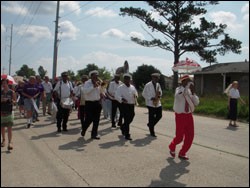In New Orleans, “second line” parades are a longstanding tradition that help to unite communities. Led by a brass band and full of dancing and celebration, the parades wind through neighborhoods with an air of joy.
On May 13, the celebration was for another type of community — one that is bound by belief rather than geography. From April 19 to May 16, Church World Service (CWS) and its 10 denominational partners — including the Presbyterian Church (U.S.A.) — worked to rebuild or repair 12 homes in a project called Neighborhood: New Orleans. This blitz, the first of its kind, joined together Christians of differing theologies in one goal: to rebuild hurricane-damaged homes in the Little Woods neighborhood of New Orleans.
The blitz culminated in a parade through the streets of the Little Woods community to the home of Gloria Mouton, one of the homeowners whose house was rebuilt by teams of volunteers.
More than 500 volunteers came from 10 denominational groups — Presbyterian Disaster Assistance, American Baptist Churches USA, Brethren Disaster Ministries, Christian Church (Disciples of Christ), Christian Reformed World Relief Committee, Lutheran Disaster Response, Mennonite Disaster Service, Reformed Church in America, United Church of Christ and the United Methodist Committee on Relief.
The volunteers came from 27 states and Canada and put in more than 20,000 hours of labor during the blitz.
“We really wanted to find a neighborhood that was beyond the media’s attention,” said Matt Hackworth, CWS communications officer. “This is a community where you can still feel Katrina in her bones.”
Little Woods faces the east bank of Lake Pontchartrain and was virtually obliterated by Hurricane Katrina. It is a working-class neighborhood whose formerly vibrant lakefront was lined with fishing camps, restaurants and music clubs, according to a CWS news release. In 1999, it was nominated as a historic landmark by the New Orleans Landmarks Commission.
CWS worked with the long-term recovery organization Crescent Alliance Recovery Effort (CARE) to identify possible communities in New Orleans to focus on. One thing that made Little Woods stand out was a public pavilion in the neighborhood. It was a sign of a community trying to unite, said Bonnie Vollmering, CWS associate director for domestic emergency response.
And stimulating a sense of community was a goal of the blitz.
Working with people of different denominations also fostered fellowship, making for a unique experience for all involved, Vollmering said.
“It was not a one-man show,” she said. “I hope it’s a model that can be used elsewhere.”
By coming together, the involved denominations were able to make a real impact in the neighborhood.
“We decided in coming together right now to do more together than we can do alone,” said Kevin Massey, a director of Lutheran Disaster Response. “You’ve done wonderful things. You’ve put lives back together,” he told the volunteers.
Although the denominations have different traditions and theologies, they are united by common faith and values, said CWS executive director and CEO John McCullough, adding that those commonalities are what motivated them to come together for the blitz.
“It is about something that is deep into the core of each and every one of us,” he said. “This is about not losing hope. This is about not giving up. This is about not giving in.”
It’s too early to plan for future blitzes. CWS executives will meet to evaluate the program, and local evaluations also need to be done, Vollmering said.
But for Mouton, whose home was the end point for the second line parade, the blitz was a success.
Mouton said she is grateful for the work of volunteers and is very happy to be back in her home.
“Words cannot express,” she said.

